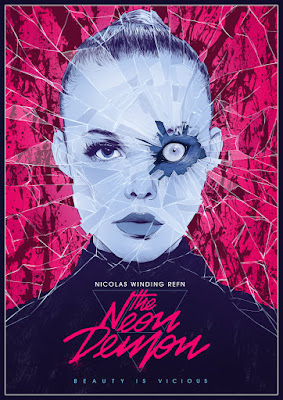Making the Mundane Monstrous: Review of The Neon Demon and Let's Be Evil
Horror is at its most effective when it takes something ordinary and recasts it as something terrifying. However, such a feat is easier said than done, which brings me to two 2016 films that I recently watched: The Neon Demon and Let's Be Evil. Both try to find the sinister in the simple, but one does it with much more skill and creativity than the other. Read on for my complete review.
In The Neon Demon, teenager Jesse (Elle Fanning) arrives in Los Angeles with the hope of breaking into the world of fashion modeling. The film chronicles Jesse's doomed path to modeling stardom, including the many narcissists, obsessives and abusers she meets along the way.
The tale of naive young women being victimized by fashion modeling and/or Hollywood have been told by countless novels, movies and TV soap operas. What sets Neon Demon apart is its approach to the subject matter: Director Nicolas Winding Refn depicts fashion modeling in such an unearthly and disorienting manner, something that has more in common with The Twilight Zone than Vogue magazine. The film is well written and perfectly cast, and Fanning carries Demon ably as the enigmatic main character. However, Refn's direction is the real star of the show, with his creative use of light, color and ambient noise that depicts the field of fashion modeling as something that would only be suited for aliens, androids and cannibals. Thomas Jerome Newton, the titular character from The Man Who Fell to Earth (1976), would completely understand.
Some horror geeks might find Neon Demon to be too "arty" for their tastes, but fans of Mario Bava and David Lynch find this film to be quite engaging. That said, this film has plenty of violent, disturbing scenes, so the fainthearted should probably look elsewhere for movies about fallen starlets.
In Let's Be Evil, Jenny (Elizabeth Morris) accepts a job as a chaperone with an educational initiative for gifted children that involves virtual reality (VR). When Jenny arrives for work, she is required to stay in a concrete bunker and supervise a group of students who don't say much and constantly interact with educational VR programs. Yet as the days wear on, she begins to suspect that the children are up to something that is very far removed from higher learning.
Let's Be Evil is the kind of movie that has an interesting idea but has absolutely no idea what to do with it. The film begins with a clip from a fake political talk show, where a pundit complains about how schools are not preparing students enough for the job market. However, instead of using the concept of educational VR to explore the all-too-real conflicts that arise when technology is blindly accepted as a solution to public schooling problems (e.g., online virtual schools), Let's Be Evil opts instead to fall back on a formulaic plot in an attempt to deliver scares. Essentially, this film is a vastly inferior version of Village of the Damned (1960), with evil telekinetic kids replaced by evil VR-enhanced kids.
What's particularly amusing about Let's Be Evil is how it tries to use slick, neon-lit CGI effects to gloss over an otherwise poor production. When Robert Downey Jr. plays Tony Stark in a scene in an Iron Man movie where Stark interacts with holographic 3D computer displays, Downey and the special effects team obviously work to make it look like Stark is actually using something (even though nothing is really there). In contrast, the kids who play the students in Evil look like they are just waving their hands in the air with no purpose in mind, and the CGI that's used to depict the VR displays with which the kids are supposed to be interacting can't hide this goof.
It also doesn't help that the script doesn't provide any clues as to why, when or how the kids became evil, or what they ultimately plan to do with their evilness. It just expects viewers to conclude that when super-smart kids are put in an isolated environment and mingle with advanced technology, they'll inevitably become evil.
Viewers should avoid Let's Be Evil, although fans of the Tron franchise will want to pick up a copy of the film's soundtrack (you can listen to it on YouTube here). Even though it was composed for something else, Julian Scherle's music sounds like it was pulled from Tron: Legacy and Tron: Uprising.








Comments
Post a Comment